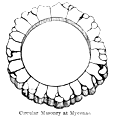Arcus
(
fornix,
καμάρα). An arch suspended
over the head of an aperture, or carried from one side of a wall to another, and serving as
the roof or ceiling to the space below. An arch is formed of a series of wedge-like stones or
of bricks, supporting each other, and all bound firmly together by the pressure of the centre
one upon them, which latter is therefore distinguished by the name of keystone.
It would seem, at first sight, that the arch, as thus defined, and as used by the Romans,
was not known to the Greeks in the early periods of their history, otherwise a language so
copious as theirs, and of such ready application, would not have wanted a name properly Greek
by which to distinguish it. The use of both arches and vaults appears,
however, to have been known to them even before the Trojan War, and its use is exemplified in
two of the earliest buildings now remaining—the chamber built at Orchomenus by
Minyas, king of Boeotia (Pausan. ix. 38), and the treasury of Atreus at Mycenae (Pausan. ii.
16). Both of these works are constructed underground, and each of them consists of a circular
chamber formed by regular courses of stones laid horizontally over each other, each course
projecting towards the interior, and beyond the one below it, till they meet in an apex over
the centre, and thus resemble the inside of a dome. Each of the horizontal courses of stones
formed a perfect circle, or two semicircular arches joined together, as the subjoined plan
will render evident. See Schliemann,
Mycenae, p. 43; Leake,
Morea, ii. 377; and the articles
Architectura;
Mycenae.
 |
|
Circular Masonry at Mycenae.
|
The principle of the construction is that of an arch-shaped mass resisting a great
superincumbent weight, and deriving its strength and coherence from the weight itself. Thus it
seems that the Greeks did understand the constructive principle on which the arch is formed.
They made use of a contrivance, even before the Trojan War, by which they were enabled to gain
all the advantages of our archway in making corridors, or hollow galleries, and which in
appearance resembled the pointed arch, such as is now termed Gothic. This was effected by
cutting away the superincumbent stones in the manner already described, at an angle
 |
|
Pointed Arch in the Walls of Tiryns.
|
of forty-five degrees with the horizon. The mode of construction and appearance of such
arches are represented in the annexed drawing of the walls of Tiryns from Sir William Gell's
Argolis.
The principle of the true arch was known to the Egyptians, but it is remarkable that they
did not make use of it in their most massive works
(Wilkinson, ii. 299, ed. of
1878). The Assyrians used it in subterranean buildings (Layard,
Nineveh,
i. 167; ii. 260). There are also a few specimens of the true arch in ancient Greece. At
Oeniadae, in Acarnania, is a postern of a perfect arch in the polygonal walls of the city
(Leake,
Northern Greece, iii. 560 seq.); and at Xerokampo, in the neighbourhood
of Sparta, is a bridge on the true arch-principle (Mure,
Tour in Greece, ii.
248), though the latter, in the opinion of many archæologists, is of Roman
construction (Dennis,
Etruria, ii. 250 seq.). But these are rare instances; and
the Etruscans are the first people who employed the true arch extensively. Hence the use of
the arch passed into the architecture of buildings. The Romans probably borrowed it from the
Etruscans. Thus the Cloaca Maxima, long held to be the oldest instance of the arch at Rome,
and attributed to the Tarquinii (see
Cloaca), closely
resembles the canal of the Marta (Dennis,
Etruria, i. 430 seq.) See pp. 373 and
628.






